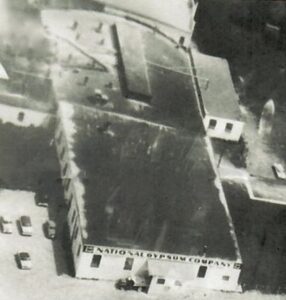My 1964 Summer Job at National Gypsum
by Ron Summers (1961 Alexandria High School graduate)

Summer break from college at Ball State was extremely memorable. First, I spent the month of May employed by the Indianapolis 500 racetrack, where one of Indy Car’s favorite drivers, Eddie Sachs, was killed in a fiery crash with Dave MacDonald. If that experience was not enough to make the summer memorable, I had managed to land a great paying summer job at the National Gypsum factory in Alexandria that would make it even more so. The job would last from June through August and would earn the money needed to pay for the school year that would begin in September.
The money sounded great, but I had no idea what I had signed myself up for! As you read the rest of this story, keep in mind that OSHA did not exist until April 1971 to require employers to follow certain safety protocol guidelines.
The Johns-Manville plant in Alexandria had been the first factory in the world to make rock wool for use as insulation. In 1943, the year I was born, Alexandria called itself “The Home of Rock Wool.”1 National Gypsum was a factory on the southside of Alexandria that competed with Johns-Manville in making rock wool not only for insulation but also for making sound-dampening ceiling tiles.
The process for making rock wool is quite simple. Simple? Yes. Easy? No. The raw material for the process is a clay-like black stone called argillite. The argillite is heated in a three-stories tall furnace until it melts at a temperature of between 1200 and 1300 degrees. The molten rock was then slowly poured onto a large rapidly spinning slotted steel disk. The spinning disk flung tiny pellets of the molten rock through the air, each pellet trailing behind it a tiny, hair-like strand of argillite to cool and solidify in the air. Those tiny hair-like strands would pile up in a large bin adjacent to the furnace, looking quite similar to white cotton candy, thus becoming rock wool.
The floor of the wool receiving bin constantly vibrated vigorously to loosen any pellets that remained within the wool and cause them to fall onto a stainless-steel floor that was slanted to send them back to the base of the furnace.
In addition to the pellets from the wool receiving bin, a substantial number of larger, heavier pellets called “shot” did not make it into the wool receiving bin, but fell instead, in the form of small marble-sized, red-hot, glowing balls into the same space on the floor between the bin and the base of the furnace.
This entire process was a very hot, noisy procedure, which also created a by-product of black rock dust particles and sent them drifting through the air, to settle on every flat or simi-flat surface in the plant. This rock dust constantly covered the ledges of the exposed steel ceiling rafters, every ledge on the walls of the plant, and the surfaces of every machine, not to mention the floor. With this dust on every surface, it is not surprising that the vibrations from the massive spinning steel wheels in the rock melting furnaces caused the entire building to constantly shake and shudder. That shaking caused the black rock dust to drift down off those surfaces and permeate the air inside the plant. Whenever a few meager shafts of sunlight managed to pierce through the filthy windows high up in the rafters, those shafts of light illuminated the sparkling dust particles in the atmosphere giving the impression that the beam of light was almost solid.
The implication of all this is, with every breath you took inside that plant, you inhaled noxious black rock dust into your lungs. At the end of a work shift, blowing your nose would fill your handkerchief with ugly black residue. It was not a pleasant thought to contemplate…
My summer job title was “Shoveling Shot.” The job required me to wear a long-sleeved shirt buttoned up to the neck which was then covered by a heavy canvas jacket with heavy gloves tied at the wrist to prevent pellets from falling into them to bum my wrists and hands, and a hard hat with a 360-degree brim to keep pellets from falling down the neck of my shirt. The fashion ensemble was completed by a pair of heavy safety goggles.
After being properly attired, I was given a wheelbarrow and a scoop shovel with instructions to shovel the red-hot pellets at the base of the furnace into the wheelbarrow until it was full, push the wheelbarrow to a nearby outside door and dump its contents on the ground where a front-loader tractor would pick up the pile and take it away to the slag heap.
Once that task was completed, I was then to return to the base of the furnace which had already replenished the pellets I had just removed with more red-hot rock pellets. The cycle was never-ending. I then repeated the scoop shovel and wheelbarrow procedure, ad infinitum, until my eight-hour shift was over. I have often been quoted as saying, “Hell cannot possibly ever be any worse than this!”
My hourly pay for performing this task was $4.00 an hour (equal to $39.68 an hour in 2023),which was a fantastic rate for a summer job. Couple that with the fact that I was doing this to earn enough money to pay for college tuition and that National Gypsum offered the option for employees to work double shifts, may help you to understand why, despite having just worked a demanding eight-hour shift “Shoveling Shot”, I volunteered almost every day, to work another eight-hour shift (aka a double shift) because it paid a time-and-a-half hourly rate of $6.00 (equivalent to $59.52 in 2023). It’s only fair to admit that I didn’t get a double shift every day, but that didn’t stop me from trying. Ah, the stamina and foolhardiness of youth!
The procedure for picking up a double shift was to go to the lunchroom and wait for one of the shift foremen to come looking for employees to fill in on jobs where the scheduled employee had failed to show up for work. That was a frequent occurrence because the working conditions were a definite disincentive for employees to come to work every day, so they didn’t. Thus, any time I wanted, which was almost every day, I went to the lunchroom and picked up an extra shift. One Friday, I actually picked up a third shift and worked 24-hours straight! That was a BIG mistake! I worked as an inspector on that third shift watching a conveyor belt of wet rock wool flow endlessly past me into an oven for eight hours. My job was to watch for lumps and to use a rake to smooth them out. It was an agonizing shift because I was so tired, I had to fight to keep my eyes open the whole time. I would literally doze off and then be jerked back awake by the responsibility I had assumed by taking that shift. There is no way to express how grateful I was when the shift ended and I could go home to sleep! I think I slept all day that Saturday…
This summer job lasted three months, from June through August of 1964, and allowed me to add $1,445 (equivalent to $14,334 in 2023) into my college fund. Not bad for a college student’s three-month gig!
1 Source: Page 31 of “Small Town U.S.A.”, a booklet published by the U.S. Office of War Communications in 1943.


